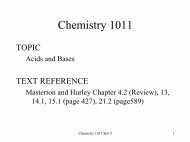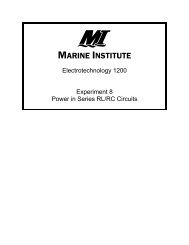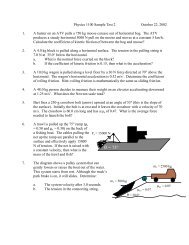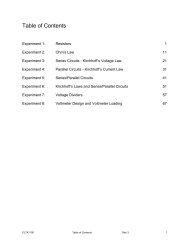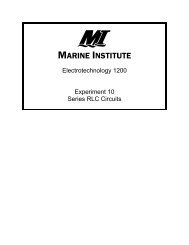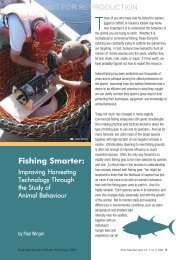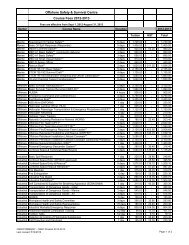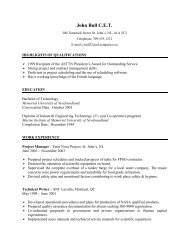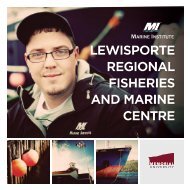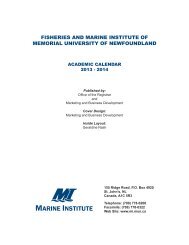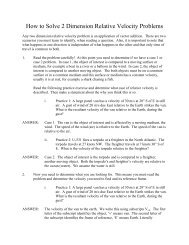Hybrid Marine Propulsion on the Tugboat Carolyn Dorothy
Hybrid Marine Propulsion on the Tugboat Carolyn Dorothy
Hybrid Marine Propulsion on the Tugboat Carolyn Dorothy
You also want an ePaper? Increase the reach of your titles
YUMPU automatically turns print PDFs into web optimized ePapers that Google loves.
of eight knots, <strong>the</strong> trawler is c<strong>on</strong>suming<br />
approximately three litres of diesel fuel per<br />
nautical mile. However, if <strong>the</strong> vessel were to<br />
reduce its speed from eight knots to five knots,<br />
<strong>the</strong> vessel would <strong>on</strong>ly require approximately<br />
<strong>on</strong>e litre of fuel per nautical mile. Therefore,<br />
a speed reducti<strong>on</strong> of 37% results in a fuel<br />
savings of 67%.<br />
The ability of shipping companies to<br />
immediately adjust vessel speed provides<br />
c<strong>on</strong>siderable flexibility to offset high fuel<br />
prices. For example, <strong>the</strong> Stena Line ferry<br />
divisi<strong>on</strong> combated high bunker costs in 1985<br />
by reducing vessel speeds from 19.8 knots<br />
to 18.7 knots, resulting<br />
in a cost savings of<br />
23%. However, speed<br />
reducti<strong>on</strong>s are not always<br />
<strong>the</strong> perfect answer for<br />
reducing fuel costs.<br />
One disadvantage is an<br />
increase of air polluti<strong>on</strong><br />
from ships’ engines<br />
operating below design<br />
parameters. In <strong>the</strong> case<br />
of a large c<strong>on</strong>tainer ship<br />
designed for 25 knots at<br />
70,000 kW main engine<br />
power, a speed reducti<strong>on</strong><br />
to 20 knots would require<br />
just 50% power and<br />
represent a total nitrogen<br />
oxide emissi<strong>on</strong>s increase<br />
of 40 t<strong>on</strong>s per year.<br />
Wea<strong>the</strong>r Systems Avoidance<br />
Wea<strong>the</strong>r analysis is an important factor for<br />
voyage planning. Selecting a specific route<br />
to ei<strong>the</strong>r avoid or navigate through a wea<strong>the</strong>r<br />
system will have direct impact <strong>on</strong> how much<br />
fuel <strong>the</strong> vessel will burn. Wea<strong>the</strong>r systems<br />
avoidance, often referred to as wea<strong>the</strong>r routing,<br />
is <strong>the</strong> practice of choosing a vessel’s optimal<br />
route to get to point A from point B based<br />
<strong>on</strong> wea<strong>the</strong>r forecasts, sea c<strong>on</strong>diti<strong>on</strong>s, and <strong>the</strong><br />
vessel’s sea-keeping characteristics. These<br />
decisi<strong>on</strong>s can be made under <strong>the</strong> professi<strong>on</strong>al<br />
judgment of <strong>the</strong> Master or by advanced wea<strong>the</strong>r<br />
predicti<strong>on</strong> models. Modern wea<strong>the</strong>r routing<br />
systems incorporate sophisticated algorithms<br />
that combine wea<strong>the</strong>r and wave forecasting<br />
with a vessel’s sea-keeping characteristics.<br />
The resulting computer-generated wea<strong>the</strong>r<br />
routes offer significant advantages to <strong>the</strong> costc<strong>on</strong>scious<br />
vessel operator.<br />
Wea<strong>the</strong>r routing services have proven <strong>the</strong>mselves<br />
useful for trans-ocean voyages. Captains using<br />
wea<strong>the</strong>r routing services have often reported<br />
higher speeds, less bunker c<strong>on</strong>sumpti<strong>on</strong>, and<br />
a better estimated time of arrival despite l<strong>on</strong>ger<br />
distances travelled. However, wea<strong>the</strong>r routing<br />
also has its limitati<strong>on</strong>s in practical use dependent<br />
up<strong>on</strong> <strong>the</strong> type of passage. Wea<strong>the</strong>r routing is<br />
Figure 2: Great circle sailing versus wea<strong>the</strong>r routing <strong>on</strong> a typical trans-Atlantic voyage.<br />
marintek<br />
not particularly useful for short passages less<br />
than 1,500 miles, passages navigati<strong>on</strong>ally<br />
restricted by land, or during passages where<br />
wea<strong>the</strong>r is not expected to be a significant factor.<br />
Great Circle Sailing<br />
A great circle route is simply <strong>the</strong> shortest route<br />
between two points anywhere <strong>on</strong> <strong>the</strong> earth’s<br />
surface. Thus, masters typically must choose<br />
<strong>the</strong> appropriate applicati<strong>on</strong> of wea<strong>the</strong>r routing<br />
or great circle routing to achieve maximum<br />
efficiency. Figure 2 shows <strong>the</strong> difference in<br />
distance between a great circle route and a<br />
wea<strong>the</strong>r route <strong>on</strong> a typical trans-Atlantic voyage.<br />
In this example, <strong>the</strong> optimal route offering <strong>the</strong><br />
Greener Ships, Vol. 4, No. 3, 2009 3



